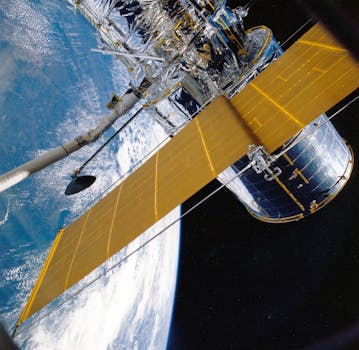The Future of Satellites: Revolutionizing Global Communication and Exploration

The Future of Satellites: Revolutionizing Global Communication and Exploration
The future of satellites holds immense potential for transforming global communication, navigation, and space exploration. With advancements in technology, satellites are becoming increasingly efficient, versatile, and affordable. The focus keyword future of satellites is an exciting topic that has garnered significant attention in recent years. As we continue to push the boundaries of space technology, it’s essential to explore the latest trends, innovations, and applications in the satellite industry.
Advancements in Satellite Technology
One of the most significant advancements in satellite technology is the development of small satellites, also known as CubeSats. These tiny satellites weigh less than 1.33 kilograms and are approximately the size of a shoebox. Despite their small size, CubeSats are equipped with advanced technology, enabling them to perform a wide range of tasks, from Earth observation to communication. The cost-effectiveness and versatility of CubeSats have made them an attractive option for startups, research institutions, and governments alike.
Another area of significant advancement is in the field of satellite propulsion systems. Traditional propulsion systems rely on chemical-based fuels, which are heavy, expensive, and have limited lifespan. However, new propulsion systems, such as ion engines and Hall effect thrusters, offer greater efficiency, longer lifespan, and reduced mass. These advancements have enabled satellites to operate for extended periods, reducing the need for replacement and increasing their overall value.
Applications of Satellites in Global Communication and Exploration
Satellites play a vital role in global communication, providing internet connectivity, telephone services, and television broadcasting to remote and underserved areas. The future of satellites holds immense potential for expanding these services, particularly with the advent of constellations like OneWeb and Starlink. These constellations aim to provide high-speed, low-latency internet connectivity to every corner of the globe, bridging the digital divide and enabling unprecedented levels of communication and collaboration.
In addition to communication, satellites are also essential for space exploration. They enable scientists to study the Earth’s climate, monitor natural disasters, and track changes in the environment. Satellites like the Hubble Space Telescope and the Kepler Space Telescope have revolutionized our understanding of the universe, discovering new planets, stars, and galaxies. The future of satellites will likely involve even more ambitious missions, such as the James Webb Space Telescope, which will study the formation of the first stars and galaxies in the universe.
Challenges and Opportunities in the Satellite Industry
Despite the many advancements and applications of satellites, the industry faces several challenges, including space debris, regulatory frameworks, and cybersecurity threats. Space debris, in particular, poses a significant threat to satellite operations, as collisions with debris can cause catastrophic damage. To mitigate this risk, satellite operators are developing new technologies, such as debris removal systems and collision avoidance maneuvers.
Regulatory frameworks are also evolving to address the growing number of satellites in orbit. Governments and international organizations are working to establish standards for satellite operations, spectrum allocation, and licensing. These efforts aim to ensure that the satellite industry continues to grow and innovate while minimizing its impact on the environment and other stakeholders.
The future of satellites also presents numerous opportunities for innovation and entrepreneurship. With the advent of new technologies and applications, startups and established companies alike are exploring new business models, such as satellite-based services, data analytics, and space tourism. As the satellite industry continues to evolve, it’s likely that we’ll see even more exciting developments and breakthroughs in the years to come.
